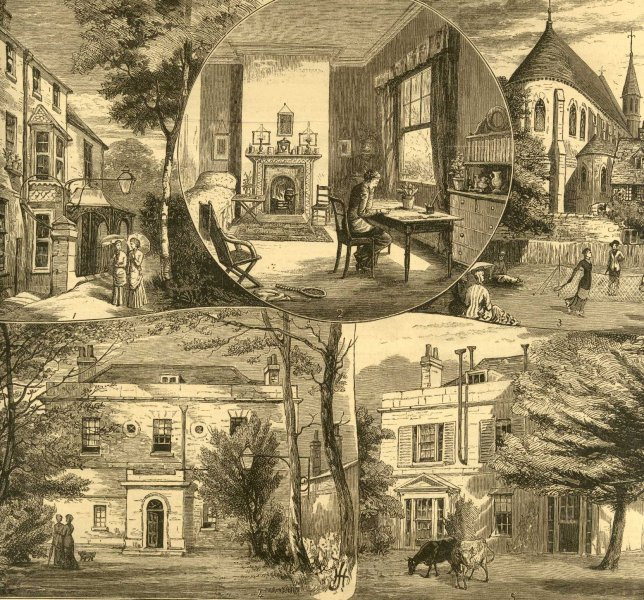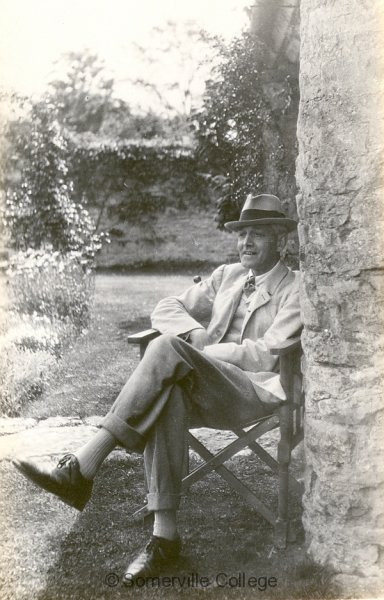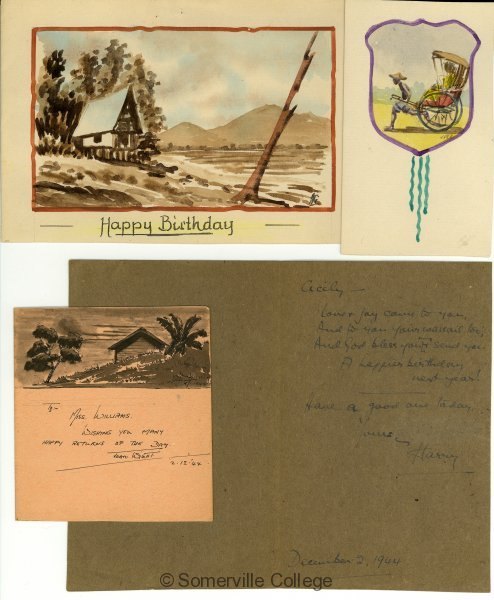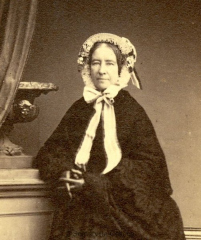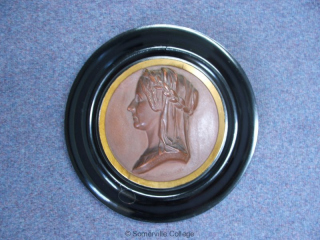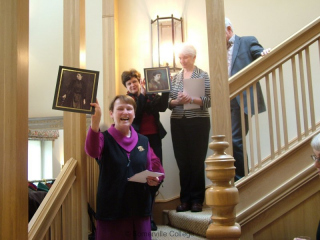In 1880 The Graphic magazine published this collection of wood-engraved vignettes of what was then the new Somerville Hall. The engravings were taken from drawings by the first Principal Madeleine Shaw Lefevre and her cousin Mrs Nigel Madan
Winifred Holtby on the first Female MPs

Winifred Holtby by F Lewis Copyright Somerville College Oxford
WINIFRED HOLTBY: AN INFORMED VIEW … AND A PRESCIENT ONE?
Hugh Gault
At the end of May 1929, and after five years of a reforming Conservative government, the first general election at which everybody aged 21 and over could vote had resulted in no clear majority. Nationally, the Labour Party had won 287 seats in parliament against 260 for the Conservatives, and it was they who took office with the tacit support of 59 Liberals led by Lloyd George.
The following month the author, activist and Somerville College graduate Winifred Holtby assessed the fourteen women elected as MPs.[1] They included Eleanor Rathbone, another Somerville graduate sitting as an Independent, and Megan Lloyd George, the sole Liberal. The three Conservatives were all returning to the Commons, the Duchess of Atholl, Lady Iveagh and Nancy Astor, as were three of the Labour women: Margaret Bondfield, Susan Lawrence and Ellen Wilkinson. The six new Labour women were Jennie Lee, Mary Agnes Hamilton, Cynthia Mosley, Marion Phillips, Ethel Bentham and Picton Turberville.
Two things stand out:
– women constituted more than 50% of the electorate but only 2% of the 615 MPs;
– yet, or perhaps partly because of this, most of the fourteen remain known today.
In addition to the achievements for which, for example, Eleanor Rathbone, Ellen Wilkinson and Nancy Astor remain known, they also helped forge a path for women representatives in the future. But they did more than this for women.
Indeed, Winifred Holtby’s opening paragraph read:
‘The day will come when the presence of women in the House of Commons will be no more noticeable than that of men, when their political preoccupations will be determined by no consideration of sex, and when the grouping together of women members will be no more significant than the grouping of members who have travelled in the Dominions, or members with a scientific training. But that time has not yet arrived. The fourteen women in the new Parliament, though they differ in their interests, party allegiance, and experience, are bound together upon certain issues by the special position which women still hold under the law and the economic system as a class apart. Not one of them perhaps is a feminist before all other claims, but on certain questions all fourteen will stand together.’
Examples of this are family allowances, education, abortion and maternal health, as well as women’s issues more generally. It is striking, for example, that one of the things Nancy Astor is known for is the Cliveden set and appeasement in the 1930s. What is far less well known is that one of her frequent guests at Cliveden was Ellen Wilkinson so that the two friends could work together on women’s rights.[2]
Holtby goes on to consider each of the fourteen women in turn, but at least as important is her overall conclusion that ‘they make a notable team’. They clearly were trailblazers for women but, even given the equal rights and gender representation initiatives of the last forty years, women occupy only 195 of 650 seats in the Commons today (30%). The gender gap remains and only when 50% of MPs are women will parliament be fully representative of the electorate. Much remains to be done.[3] Yet for all that, Holtby’s article remains prescient – if still predictive rather than the result itself.
hg/whm/WH 090629 ST article/ 180117
[1] Sunday Times 9th June 1929
[2] University of Reading Special Collections hold the Cliveden visitor books which I examined in March 2015. One of Ellen Wilkinson’s biographers explained their connection later that month.
[3] www.parliament.uk/about/parliament-and-women/
Somerville’s Archives Blog relaunches!
We are very excited to announce that we have relaunched the Somerville Archives Blog under the new title History of Somerville College Blog to be more representative of the items we plan to include. Our first post is from a guest contributor: historian and author Hugh Gault who writes about alumna Winifred Holtby and her review of the first women MPs in 1929.
We welcome contributions on subjects of a historical nature relating to Somerville – please contact archives@some.ox.ac.uk if you would like to submit a piece which should be no more than 500 words long.
A rare talent for friendship – Percy Withers
In 1976 a remarkable collection of letters, books, artwork and ephemera was given to the college by a Somerville alumna, Audrey Kennet (née Withers, 1924-7) and her sister Monica. The gift was made in honour of their parents Dr Percy and Mrs Mary Withers (née Summers, Somerville, 1889-92), who were at the centre of an illustrious circle of friends including many of the foremost British writers and visual artists of the inter-war period. This collection has now been fully catalogued for the first time, revealing a significant and intriguing body of work.
Percy Withers (1867-1945) was a G.P. before retiring to Souldern Court and then Epwell Mill in Oxfordshire. Although he had literary ambitions he was not conspicuously successful as an author himself; his greatest legacy is in the volume of correspondence left to his daughters. Dr Withers had a rare talent for friendship, and cultivated a distinguished literary and artistic coterie who obviously valued his genuine interest in their work as well as his personal and professional support. Most appear to have had great affection for him – including the famously reserved poet A.E. Housman – and frequently enjoyed the Withers household’s hospitality.
This collection presents in a unique light the output, personal relationships and working practices of some of the early 20th century’s most important writers and artists, notably Robert Bridges (some 30 letters), A.E. Housman (66), Walter de la Mare (78) and members of the Dymock group of poets. Their correspondence with Dr Withers is candid, even unguarded, since Withers was neither rival nor critic. He was a connoisseur, however, and in gratitude for his friendship and hospitality he was gifted original artwork and poetry, as well as the confidence of a remarkably wide range of distinguished friends including Max Beerbohm, Edmund Blunden, Marie Corelli, Alice Meynell, William Rothenstein, John and Paul Nash, Graham Sutherland and W.B. Yeats.
We are planning an Exhibition based on the collection for later this year: watch this space
Refugees Scholars at Somerville
Helen Darbishire and an extract from one of her letters in support of Lotte Labowsky’s father
As with many primary sources, the Somerville Minutes of Council were created as an official record of the insitution yet they are inadvertently informative about the world outside the College walls. In the 1930s, they provide a valuable account of the response of British academia to the persecutions of the Nazi regime.
Hitler’s appointment as German Chancellor in January 1933 was soon followed by the dismissal of prominent Jewish professors. By May 1933 the Academic Assistance Council had been founded to help the persecuted seeking to leave Germany and an appeal was made to universities across Britain to assist with offers of work and sponsorship.
Somerville’s Principal, Helen Darbishire, was particularly active in Oxford’s refugee schemes. To augment College payments, she established a fund for the assistance of Dismissed German Women Scholars, appealing to the Association of Senior Members via that year’s ASM annual report. The Council minutes of October 1933 note that the Principal and Fellows had already agreed to offer temporary appointments where possible and Frau Dr Margarete Bieber, the former Professor of Classical Archaeology at Gottingen University, was one of the first to benefit, being offered an Honorary Research Fellowship and hospitality for three terms. Dr Bieber was also employed to give a course of lectures, funded jointly by the women’s colleges.
The College assisted other refugee women scholars, ( Elise Baumgartel,
Kathe Bosse, Leonie Zuntz, Gertrud Herzog Hauser and Lotte Labowsky) with offers of research grants, hospitality and employment, endeavouring to use the limited finances at its disposal to the greatest effect. When internment as an enemy alien threatened, Helen Darbishire’s testimonials were instrumental in securing Dr Labowsky’s continued liberty and obtaining the release of her father. Such scholars in turn benefitted Oxford and its Colleges by their contributions to academic and community life. Lotte Labowsky’s association with Somerville, as acting librarian, research fellow and additional fellow amongst other roles, was to continue until the end of her life in 1991 and beyond, with a major bequest to the College.
Birthday in Changi Prison
The recent film ‘The Railway Man’ tells the story of Eric Lomax, a British soldier captured by the Japanese in World War 2 and held in Changi Prison before being sent to work on the infamous Burma railway. As well as thousands of soldiers, around 3,000 civilians were incarcerated in Changi, including Somervillian Dr. Cicely Williams. One of the first women to be admitted to degrees in 1920, she completed her medical training at Kings College Hospital in London and went on to specialize in paediatrics and nutrition, working for the colonial medical service on the Gold Coast and in Malaya. A proponent of breast feeding, she was an early critic of companies marketing tinned alternatives in developing countries (her talk ‘Milk and Murder’ to the Singapore Rotary Club predated the first international code on such practices by 40 years). Captured after the fall of Singapore in February 1942, she was incarcerated in Changi Prison for most of the war, with five months spent under arrest as a suspected spy, during which she was imprisoned by the Kempeitai (secret police) in a series of cramped and insanitary shared cages.
In Changi, her skills and expertise were invaluable; she later recalled “twenty babies were born, 20 breast fed and 20 survived – you can’t do better than that.” As well as doctor and dietician, she later became commandant of the women’s camp. These birthday cards were given to her by her fellow prisoners in 1944 and are now deposited in the Somerville College Archives, testimony to an extraordinary woman, to her strength and resilience and to that of her fellow prisoners.
Online Catalogue Complete
The project to upgrade and digitise the catalogue of the papers of Mary Somerville (1780-1872) is now complete. For the first time, researchers all over the world will be able to have access to the complete listing of the collection which is owned by Somerville College but held by the Bodleian Library. During the cataloguing process some interesting documents have been unearthed including a letter from Charles Babbage inviting the Somervilles to view his ‘Calculating Engine’ (a mechanical calculator that was the forerunner of the modern computer), a request from John Stuart Mill for Mary Somerville to sign his petition for women’s suffrage and a letter from Charles Darwin commenting on one of her publications. The project has been enabled by a generous grant from the Gladys Krieble Delmas Foundation and the catalogue may be found and searched via the Bodleian Special Collections website.
Now that the catalogue has been made available online we are working towards the next stage of the project which is to digitise some of the papers themselves for the purposes of preservation and to make them more widely available. Fundraising has begun for this and we hope to be able to start this phase towards the end of 2013. Please contact the Librarian if you would like to help us with this exciting project.
Updating the Mary Somerville Online Catalogue
The first phase of this project is almost complete, with the catalogue of the collection amended and updated (in compliance with Bodleian guidelines) and the documents themselves curated and rehoused in archival-standard acid-free folders and boxes.
And what a fascinating collection it is! Containing a vast array of papers relating to all aspects of Mary Somerville’s life, work and family history, the collection ranges from personal correspondence and business papers to the hand-written manuscripts for her publications, as well as a considerable number of letters from Victorian ‘celebrities’ .
The collection also contains some unexpected and rare specimens, including a letter from George Washington to his ambassador in Paris in June 1793 (a gift to Mary Somerville from a friend and admirer), copies of family marriage contracts and bonds and letters from Mary Somerville’s scientific peers, including Charles Babbage, Ada Lovelace, John Herschel and Michael Faraday. One interesting item is a letter from the social reformer and feminist Josephine Butler inviting Mrs Somerville to add her name (along with Harriet Martineau and Florence Nightingale) in support of the foundation of a national ladies association. Undated but probably written in 1869, it show that despite having lived in Europe for over 30 years and approaching her 90th birthday, Mary Somerville was still highly regarded in Victorian society for her scholarship, her skills in communicating and popularizing science and her judgment and conduct as the epitome of female probity.
Mary Somerville
 Somerville College was named after the renowned mathemetician, astronomer and scientist, Mary Somerville (1780-1872). The College is fortunate to own her papers which were given by the descendents of Mary Somerville, the Fairfax-Lucy family. The papers are held in the Bodleian Library and for many years access to their contents has been via a typewritten list available only at Somerville College or at the Bodleian itself. This year, thanks to a generous grant from the Gladys Krieble Delmas Foundation, the College has been able to begin the task of updating the listing to 21st Cenury cataloguing standards and transferring it to the Bodleian’s Online Special Collections catalogue so that scholars all over the world will be able to search the catalogue for items of interest. The project is due to be completed in the Spring of 2013. Staff working on the project will be going through all the papers and items in the collection, reboxing and refiling where necessary, noting items of interest discovered along the way (and updating this blog with them!)
Somerville College was named after the renowned mathemetician, astronomer and scientist, Mary Somerville (1780-1872). The College is fortunate to own her papers which were given by the descendents of Mary Somerville, the Fairfax-Lucy family. The papers are held in the Bodleian Library and for many years access to their contents has been via a typewritten list available only at Somerville College or at the Bodleian itself. This year, thanks to a generous grant from the Gladys Krieble Delmas Foundation, the College has been able to begin the task of updating the listing to 21st Cenury cataloguing standards and transferring it to the Bodleian’s Online Special Collections catalogue so that scholars all over the world will be able to search the catalogue for items of interest. The project is due to be completed in the Spring of 2013. Staff working on the project will be going through all the papers and items in the collection, reboxing and refiling where necessary, noting items of interest discovered along the way (and updating this blog with them!)
Phase 2 of the project will be to digitise the papers once they have been curated and catalogued. We are currently looking for ways of funding this part of the project – all suggestions gratefully received!
Blue Plaque for Mrs Humphry Ward
 On Saturday 28th April 2012, one of the founders of Somerville College and its first Secretary of Council, Mary Ward (also known as Mrs Humphry Ward) was honoured in Oxford with a Blue Plaque on the house in North Oxford where she lived from 1872-1881. Somerville Principal, Dr Alice Prochaska, spoke to the assembled company about Mary Ward’s contribution to the development of higher education for women and presented the current owners of the house with two portraits of Mary Ward. Amongst the people at the ceremony were three great-grandsons of Mary Ward and two great-great granddaughters.
On Saturday 28th April 2012, one of the founders of Somerville College and its first Secretary of Council, Mary Ward (also known as Mrs Humphry Ward) was honoured in Oxford with a Blue Plaque on the house in North Oxford where she lived from 1872-1881. Somerville Principal, Dr Alice Prochaska, spoke to the assembled company about Mary Ward’s contribution to the development of higher education for women and presented the current owners of the house with two portraits of Mary Ward. Amongst the people at the ceremony were three great-grandsons of Mary Ward and two great-great granddaughters.

